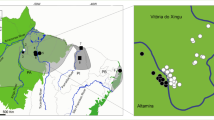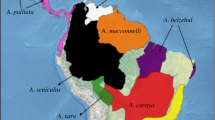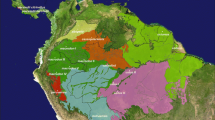Abstract.
Molecular phylogenetic analyses of seven Brazilian Alouatta species, based on cytochrome b DNA sequence data were carried out. Parsimony and neighbor joining topologies grouped Alouatta belzebul and A. fusca as sister groups in one clade while another, well-supported clade contained A. seniculus as the most basal offshoot, followed by A. nigerrima as a sister lineage of A. macconnelli/A. stramineus. Estimates of inter-specific sequence divergence were generally low, and estimates of the time of divergence indicated that the main Alouatta lineages emerged during a short evolutionary interval. A comparison with karyotypic data confirmed the molecular topology showing a closer relationship between A. macconnelli and A. stramineus in respect to A. nigerrima. It also showed that the XX/XY sex chromosome system was maintained in several lineages while the X1X2Y/X1X1X2X2 system appeared independently at least three times during the radiation of howler monkeys. Moreover, the X1X2Y1Y2/X1X1X2X2 system might have appeared once or, alternatively, twice and independently.
Similar content being viewed by others
Author information
Authors and Affiliations
Additional information
In revised form: 28 December 2000
Electronic Publication
Rights and permissions
About this article
Cite this article
Bonvicino, C.R., Lemos, B. & Seuánez, H.N. Molecular phylogenetics of howler monkeys (Alouatta, Platyrrhini). Chromosoma 110, 241–246 (2001). https://doi.org/10.1007/s004120000128
Received:
Accepted:
Issue Date:
DOI: https://doi.org/10.1007/s004120000128




